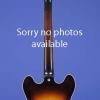A Great 60's Slide Guitar
This 13-inch-wide solid body guitar weighs 6.20 lbs. and has a nice, fat nut width of just over 1 11/16 inches and a scale length of 24 1/2 inches. Masonite top, poplar frame, poplar neck with aluminum nut, and Brazilian rosewood fretboard with 21 frets and white dot position markers. Headstock with silver silk-screened "Silvertone" logo. One-piece six-in-a-line metal tuners with "Skate Key" stamped buttons. Two "lipstick tube" pickups with alnico bar magnets and outputs of 3.19k and 4.44k. Baked melamine pickguard. Two concentric stacked tone and volume controls, plus a three-way selector switch and jack socket, all on pickguard. White plastic knobs with silver dots. Combination rosewood bar bridge/stud tailpiece. Serial number ("2125") inside the neck cavity. The serial number on the amplifier is "185.11090." This guitar is in excellent plus (8.75) condition. There are a few small marks on the edges of the body and on the edge of the headstock. Housed in the original five-watt "Amplifier" case with an eight-inch speaker (9.50). With chrome trim around the speaker cut-out on the outside of the case. The guitar and amp in the case weigh approximately 25.00 lbs.
"It's likely that more American musicians began their interest in guitar-playing on a Silvertone -- as sold by Chicago's Sears, Roebuck & Co -- than on any other beginner guitar. Supplanting the Supertone brand when Sears divested itself of the Harmony guitar company in 1940, Silvertone was a former brand for radios, record-players and records. It was first applied to guitars in 1941. A Silvertone version of the Kay Thin Twin and Sears' first Les-Paul-style Harmony solidbody appeared in 1954. That same year the first of several Danelectro-made Silvertone solidbodies appeared, followed by masonite-and-vinyl hollowbodies in 1956...The single-pickup amp-in-case guitars debuted in 1962" (Tony Bacon, Electric Guitars: The Illustrated Encyclopedia, p. 282).
"By 1962 the only Danelectro guitar offered by Sears was the new amp-in-case guitar, a single-pickup short-horn in black metalflake. The brillantly simple idea was that built into the guitar's case was a three-watt amp and 6" speaker, providing the guitarist with a portable electric guitar outfit. This was joined in 1963 by a two-pickup version in red sunburst that came with a deafening five-watt amp, 8" speaker and tremolo. The six-tuners-in-line headstocks now looked like meat cleavers. In 1967 the amp-in-case guitars changed to a new Fender Jaguar-style shape" (Tony Bacon, Electric Guitars: The Illustrated Encyclopedia, p. 46).
"Before Nathan Daniel started the Danelectro company in 1947, he made amplifiers for Epiphone from 1934 to 1946. Epiphone wanted Daniel to make amps for them exclusively, but he preferred to stay independent. Instead he founded the Danelectro company in 1947 and started making amplifiers for Montgomery Ward. By 1948 Daniel expanded and became the exclusive guitar amplifier producer for Sears & Roebuck. At the same time he was also supplying other jobbers such as Targ & Dinner of Chicago. In the fall of 1954, Daniel started production of solidbody guitars for Sears, under the Silvertone name. He also produced the same guitars under the Danelectro name, sold to other jobbers. These early models didn't have truss rods but had a 3/4" square aluminum tube beginning at the peghead and through the body to the bridge. The bodies were constructed of solid Poplar wood. The Silvertone models were covered with a dark maroon vinyl covering, while the Danelectro models were covered in a whitish tweed material. Both lines came with either 1 or 2 pickups, concealed under a baked melamine pickguard. Concentric stacked tone and volume knobs were used on the two pickup models only. Notably, when both pickups were used together, the tone was much stronger. This was due to wiring the pickups in series, instead of parallel like most other maker's two pickup guitars. By the fall of 1956, Daniel started making the Silvertone and Danelectro lines using the standard Dano materials: a Poplar wood frame (that comprised the sides, neck and bridge block of the guitar), stapled together and covered with 3/8" thick masonite. The top and back was painted, but the sides were covered in a vinyl material to hide the unpainted poplar wood frame. Also the now infamous "Lipstick tube" pickups were used. These pickups had an alnico bar magnet and coil measuring 4.75k ohms wrapped in brown vinyl tape. The pickup guts were placed inside surplus, chrome plated, lipstick tubes. These pickups were actually the same as previously used and hidden beneath the pickguard. Just now they were adorned in lipstick tubes and mounted in cutouts in the masonite body. Construction methods stayed this way for most models throughout Danelectro's history" ("The History of Danelectro" at http://www.danguitars.com/TheHistoryofDanelectro.html).
Translate:

